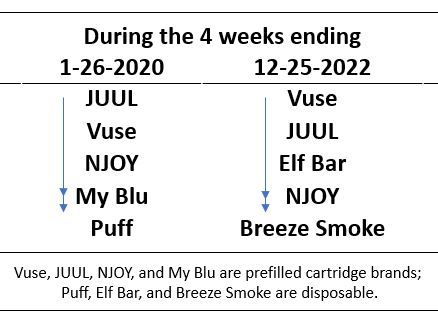E-Cigarettes: US Sales Nearly Double over 2 Years, Youth Prefer Flavored Disposables
©Atlas/Adobe Stock

E-cigarette unit sales in the US surged by 46.6% between January 2020 and December 2022, according to a new report by the CDC Foundation, the Truth Initiative, and the Office on Smoking and Health, National Center for Chronic Disease Prevention and Health Promotion of the Centers for Disease Control and Prevention (CDC).
The study, published in Morbidity and Mortality Weekly, found that user preference for method of delivery has shifted over time with flavored disposable e-cigarette products quickly becoming more popular than prefilled cartridges. Sales of the fruit- and sweet-flavored disposable units increased steadily after January 2020, when the US Food and Drug Administration banned sales of mint and other flavored prefilled cartridges.
Study authors describe the fruit flavors as “youth appealing,” underscoring the lure of e-cigarettes to individuals younger than age 18 years. Indeed, the report confirms that e-cigarette use among youths and young adults is significantly higher than among adults overall. In 2022, the study found, an estimated 2.14 million high school students, approximately 14.1%, reported current e-cigarette use. In contrast, data from 2021 for adult use revealed 4.5% of all adults aged ≥18 years and 11% of young adults aged 18 to 24 years currently used the devices.
Moreover, according to the study findings, among US middle and high school students who report using e-cigarettes, flavored disposable units, led by the brand Elf Bar, are now the most popular. Among the many concerns around youth tobacco use of any kind, the adolescent brain continues to develop through age 25 years, exposing younger users to potential adverse effects in addition to the potential for nicotine addiction, the authors caution.
Tracking e-cigarette sales and usage patterns is essential to developing and deploying public health strategies that target current and prevent future youth tobacco use, wrote first author Fatma Romeh Ali, PhD, from the CDC Foundation, and a team of investigators.
Romeh and colleagues analyzed retail scanner data from January 26, 2020, to December 25, 2022, provided by a national analytics and market research organization to assess current trends in e-cigarette unit sales by product and flavor, and top-selling brands.
FINDINGS
Investigators reported a steep decline in unit shares of e-cigarette prefilled cartridges, which dropped from 75.2% to 48% of total sales, whereas disposable e-cigarette unit shares more than doubled during the study period, rising from 24.7% to 51.8% of total unit sales.
Overall unit shares of non-menthol tobacco and mint-flavored products declined appreciably (from 28.4% to 20.1% and from 10.1% to 5.9%, respectively), while other flavor sales increased sharply, from 29.3% to 41.3%.
Analysis of unit shares of sales by flavor for the more popular disposable e-cigarettes found that by December 2022, that market was led by the combined category of flavors other than tobacco, menthol, or mint (79.6%); mint-flavored products accounged for 11.1% and tobacco- and menthol-flavored sales accounted for 4.3% and 3.6%, respectively.
Taken together the data point to sales of the fruit and other sweet flavors identified earlier as responsible for more than three-quarters of disposable e-cigarette unit sales at the end of the study period.
Mercurial market
The study authors note the fluidity of the e-cigarette market is aptly illustrated by the increase in total number of brands available over the study period, which rose from 184 at the end of January 2020 to 269 at the end of December 2022—an increase of 46.2%. The top 5 brands at each of those points is shown below, in descending order.

Romeh et al report that while total e-cigarette unit sales increased dramatically over the course of the study period, a decline observed from May to December of 2022 may have been influenced by, among other factors, state and local restrictions on sales of flavored tobacco producta, COVID-19-related supply chain disruptions, inflation, and a newly-available “large-format” disposable e-cigarette that, unlike standard devices, delivers thousands of “puffs” per unit, with the potential to deliver higher total amounts of nicotine.
When the study's sales data are assesed along side behavioral data, it is clear that "e-cigarette landscape and use patterns rapidly shift in response to market changes, policy interventions, and other factors,” wrote the research team. The report notes that restrictions on the sale of flavored e-cigarettes are in place in 7 states and in a variety of cities, towns, and villages throughout the country. While the policies vary in how comprehensive they are, the authors cite research showing that well-enforced restrictions of flavored product sales led to declines in total e-cigarette sales and tobacco product use among young people.
“These strategies, when coupled with longstanding evidence-based strategies to prevent youth tobacco use such as price increases, comprehensive smokefree policies that include e-cigarettes, and counter-marketing campaigns, are expected to reduce youth initiation and use as well as reduce disparities in tobacco product use," the authors concluded.

Reference: Ali FRM, Seidenberg AB, Crane E, et al. E-cigarette unit sales by product and flavor type, and top selling brands, United States, 2020–2022. MMWR Morb Mortal Wkly Rep. 2023;72:672–677. doi: http://dx.doi.org/10.15585/mmwr.mm7225a1